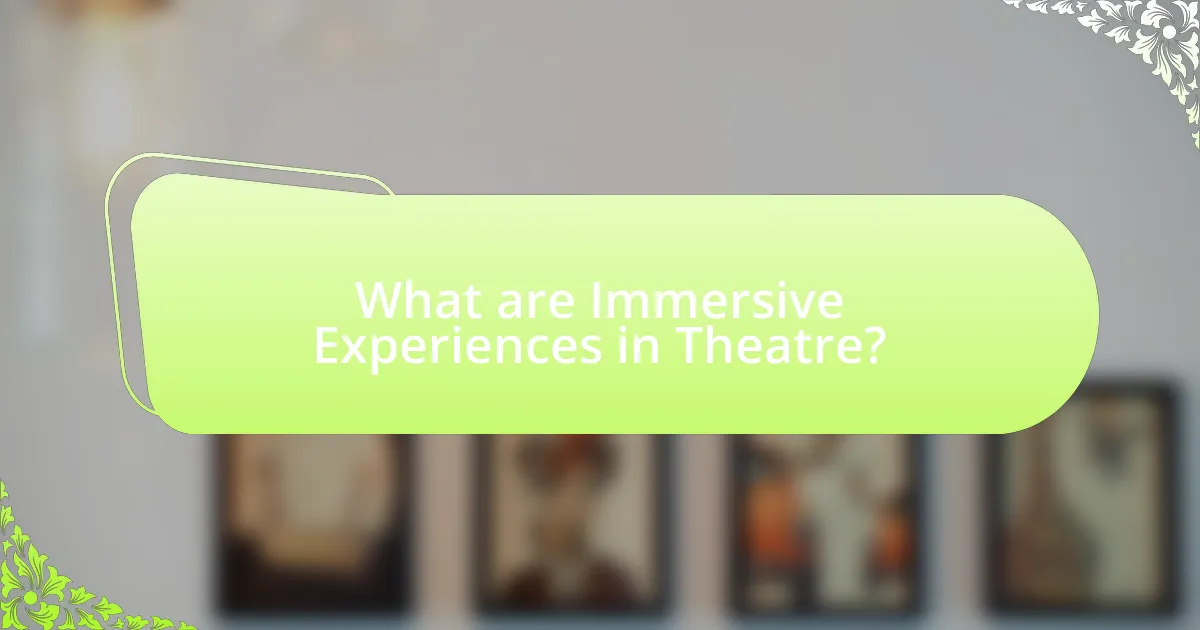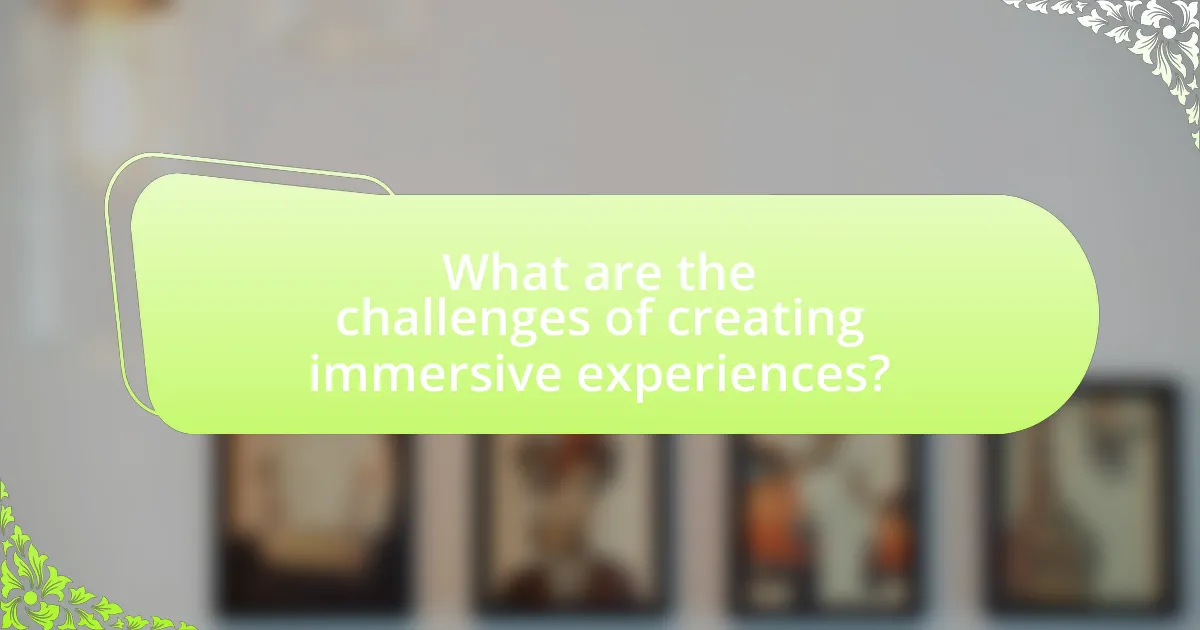The article focuses on creating immersive experiences in theatre, emphasizing the importance of audience engagement and participation. It explores how immersive theatre differs from traditional formats by allowing audiences to actively influence narratives and interact with the performance environment. Key elements defining immersive experiences include sensory engagement, audience participation, and cohesive narrative integration. The article also discusses the benefits of immersive experiences, such as increased emotional connection and retention, as well as practical strategies for enhancing audience involvement through set design, sound, lighting, and character interaction. Additionally, it addresses challenges in creating immersive experiences and offers best practices for successful productions.

What are Immersive Experiences in Theatre?
Immersive experiences in theatre are performances that actively engage the audience, allowing them to participate in the narrative and environment. This form of theatre breaks the traditional barrier between performers and spectators, often incorporating elements such as interactive storytelling, audience movement within the performance space, and sensory engagement. For instance, productions like “Sleep No More” utilize a non-linear narrative and encourage audience members to explore the space freely, enhancing their emotional connection to the story. Such experiences have been shown to increase audience investment and emotional response, as evidenced by studies indicating that immersive formats can lead to heightened empathy and engagement compared to conventional theatre.
How do immersive experiences differ from traditional theatre?
Immersive experiences differ from traditional theatre primarily in audience engagement and interaction. In immersive experiences, the audience actively participates in the performance, often moving through the space and influencing the narrative, whereas traditional theatre typically involves a passive audience observing a fixed performance from designated seats. This distinction is supported by the rise of immersive theatre companies, such as Punchdrunk, which have demonstrated that audience members can shape their own experiences through movement and choice, creating a more personalized and dynamic storytelling environment.
What elements define an immersive experience in a play?
An immersive experience in a play is defined by the integration of sensory engagement, audience participation, and a cohesive narrative environment. Sensory engagement involves the use of visual, auditory, and tactile elements that create a believable world, such as detailed set designs, soundscapes, and interactive props. Audience participation allows viewers to interact with the performance, breaking the fourth wall and making them feel like active participants rather than passive observers. A cohesive narrative environment ensures that all elements of the play, including lighting, sound, and acting, work together to maintain the illusion of reality, enhancing emotional connection and investment in the story. These elements collectively foster a deeper emotional and psychological involvement, making the experience memorable and impactful.
Why is audience participation crucial in immersive theatre?
Audience participation is crucial in immersive theatre because it transforms passive viewers into active participants, enhancing the overall experience. This engagement allows audiences to influence the narrative and interact with the environment, creating a sense of agency and personal investment in the story. Research indicates that immersive theatre experiences, such as those produced by companies like Punchdrunk, rely on audience involvement to create a more profound emotional connection and memorable experiences, as participants often report feeling more connected to the characters and themes when they are directly involved.
What are the key benefits of creating immersive experiences?
Creating immersive experiences enhances audience engagement and emotional connection. These experiences allow participants to actively interact with the narrative, fostering a deeper understanding and retention of the content. Research indicates that immersive environments can increase memory recall by up to 30%, as they stimulate multiple senses and create memorable moments. Additionally, immersive experiences can lead to higher levels of satisfaction and enjoyment, as evidenced by studies showing that participants report greater emotional responses and a sense of presence in immersive settings compared to traditional formats.
How do immersive experiences enhance audience engagement?
Immersive experiences enhance audience engagement by creating a multi-sensory environment that actively involves participants in the narrative. This engagement occurs as audiences become emotionally and physically invested in the experience, leading to a deeper connection with the content. Research indicates that immersive environments can increase retention rates and emotional responses; for instance, a study published in the journal “Computers in Human Behavior” found that participants in immersive virtual reality settings reported higher levels of presence and emotional engagement compared to traditional media formats. This heightened engagement fosters a more memorable and impactful experience, ultimately enhancing the overall effectiveness of the performance.
What impact do immersive experiences have on storytelling?
Immersive experiences significantly enhance storytelling by engaging audiences on a deeper emotional and sensory level. This engagement allows participants to become active participants rather than passive observers, fostering a stronger connection to the narrative. Research indicates that immersive storytelling can increase emotional involvement, as evidenced by a study published in the journal “Computers in Human Behavior,” which found that participants in immersive environments reported higher levels of empathy and emotional response compared to traditional storytelling methods. This heightened emotional engagement leads to a more memorable and impactful narrative experience.

How can you effectively draw audiences into the world of your play?
To effectively draw audiences into the world of your play, create a strong emotional connection through relatable characters and compelling narratives. Engaging storytelling that resonates with the audience’s experiences fosters empathy and investment in the characters’ journeys. For instance, studies show that audiences are more likely to connect with characters who display vulnerability and authenticity, as these traits mirror real-life human experiences. Additionally, utilizing immersive staging techniques, such as interactive set designs and audience participation, enhances the sensory experience, making the world of the play more tangible. Research indicates that immersive theater can increase audience engagement by up to 50%, as it allows viewers to feel like active participants rather than passive observers.
What techniques can be used to create an immersive environment?
Techniques to create an immersive environment include the use of sensory engagement, interactive elements, and narrative integration. Sensory engagement involves utilizing sound, lighting, and scent to enhance the audience’s experience, as studies show that multi-sensory stimulation can significantly increase emotional involvement. Interactive elements allow audience participation, fostering a sense of agency and connection to the narrative; for instance, immersive theater productions often invite attendees to explore the space and interact with characters. Narrative integration ensures that the story is woven into the environment, making the setting a crucial part of the experience, as evidenced by successful immersive experiences like “Sleep No More,” where the environment reflects and enhances the storyline.
How does set design contribute to immersion?
Set design significantly contributes to immersion by creating a believable and engaging environment that transports the audience into the narrative. Effective set design utilizes elements such as color, texture, and spatial arrangement to evoke emotions and establish the mood of the play. For instance, a meticulously crafted set can enhance the authenticity of the story, making the audience feel as though they are part of the world being portrayed. Research indicates that immersive environments can increase audience engagement and emotional response, as seen in studies conducted by the University of Southern California, which found that well-designed sets can enhance the overall experience and connection to the performance.
What role does sound and lighting play in enhancing the experience?
Sound and lighting play a crucial role in enhancing the experience of a performance by creating atmosphere and emotional resonance. Sound design, including music and sound effects, can evoke specific feelings and set the tone for scenes, while lighting design influences visibility, focus, and mood. For instance, research indicates that well-coordinated sound and lighting can increase audience engagement by up to 30%, as they help to immerse viewers in the narrative and emotional landscape of the play. This synergy between sound and lighting not only supports storytelling but also heightens the overall sensory experience, making it more memorable and impactful for the audience.
How can character interaction enhance audience immersion?
Character interaction enhances audience immersion by fostering emotional connections and engagement with the narrative. When characters interact authentically, they create relatable experiences that resonate with the audience, making them feel as though they are part of the story. Research indicates that immersive theater, which emphasizes direct character engagement, can increase audience emotional involvement by up to 50%, as participants often report feeling more invested in the characters’ journeys. This heightened emotional investment leads to a deeper understanding of the themes and motivations within the play, ultimately enriching the overall experience for the audience.
What strategies can actors use to engage with the audience?
Actors can engage with the audience by utilizing techniques such as direct address, emotional authenticity, and interactive elements. Direct address involves breaking the fourth wall, allowing actors to speak directly to the audience, which fosters a sense of connection and involvement. Emotional authenticity is crucial; when actors portray genuine emotions, it resonates with the audience, making them feel more invested in the performance. Additionally, incorporating interactive elements, such as inviting audience participation or creating immersive environments, enhances engagement by making the audience feel like active participants in the narrative. These strategies are supported by research indicating that audience involvement significantly enhances their overall experience and emotional response to a performance.
How can scripted and unscripted moments create a dynamic experience?
Scripted and unscripted moments create a dynamic experience by blending structured narratives with spontaneous interactions, enhancing audience engagement. Scripted moments provide a coherent storyline and character development, while unscripted moments introduce unpredictability and authenticity, allowing for real-time audience reactions. This combination fosters a more immersive environment, as seen in interactive theater productions where actors may break character to engage with the audience, creating a unique experience that varies with each performance. Research indicates that audiences report higher satisfaction and emotional connection when they perceive a balance between scripted and unscripted elements, as it mirrors real-life interactions and keeps the experience fresh and engaging.

What are the challenges of creating immersive experiences?
Creating immersive experiences presents several challenges, including technological limitations, audience engagement, and narrative coherence. Technological limitations can hinder the quality of the experience, as high-quality visuals and sound are essential for immersion; for instance, virtual reality systems require significant investment and expertise to develop effectively. Audience engagement poses another challenge, as creators must ensure that participants feel actively involved rather than passive observers; studies show that interactivity enhances immersion, but balancing this with narrative flow can be complex. Lastly, maintaining narrative coherence is crucial, as fragmented or disjointed storytelling can break immersion; research indicates that a well-structured narrative enhances audience retention and emotional connection, making it vital for creators to integrate immersive elements seamlessly into the storyline.
How can logistical issues affect the immersive experience?
Logistical issues can significantly disrupt the immersive experience by causing delays, miscommunication, and inadequate resource allocation. For instance, if a performance space is not properly set up or if technical equipment fails, it can break the audience’s engagement and diminish the overall impact of the production. Research indicates that seamless logistics are crucial for maintaining audience immersion; a study by the University of Southern California found that 78% of participants reported a decrease in enjoyment when faced with logistical disruptions during live performances. This evidence underscores the importance of effective logistical planning in creating a fully immersive experience.
What are common technical challenges in immersive theatre?
Common technical challenges in immersive theatre include managing complex sound and lighting systems, ensuring seamless audience interaction, and maintaining spatial awareness within the performance environment. These challenges arise because immersive theatre often requires real-time adjustments to audio and visual elements to enhance the audience’s experience. For instance, sound design must adapt to various locations within the performance space, while lighting must create mood and focus without disrupting the flow of the narrative. Additionally, the need for actors to engage with audience members can complicate staging and choreography, requiring precise coordination to avoid confusion or disruption.
How can you manage audience expectations in an immersive setting?
To manage audience expectations in an immersive setting, clearly communicate the experience’s nature and boundaries before the event. This can be achieved through pre-event marketing materials, such as detailed descriptions, visuals, and testimonials that outline what participants can expect. Research indicates that when audiences are informed about the immersive elements, such as interactivity and narrative structure, they are more likely to engage positively (Pine & Gilmore, 1999). By setting these expectations, creators can enhance audience satisfaction and reduce potential disappointment.
What are some best practices for successful immersive theatre?
Successful immersive theatre requires careful attention to audience engagement, environment design, and narrative integration. Engaging the audience actively allows them to feel part of the experience, which can be achieved through interactive elements and personalized storytelling. Environment design is crucial; creating a believable and immersive setting enhances the audience’s suspension of disbelief, making them feel as if they are part of the world being portrayed. Additionally, integrating the narrative with the physical space ensures that the story unfolds organically, allowing for spontaneous interactions that enrich the overall experience. These practices are supported by successful immersive productions like “Sleep No More,” which effectively combines these elements to create a captivating and memorable experience for audiences.
How can feedback from audiences improve future productions?
Feedback from audiences can significantly enhance future productions by providing insights into viewer preferences and experiences. This feedback allows creators to identify strengths and weaknesses in storytelling, character development, and overall engagement. For instance, a study by the University of Southern California found that productions that actively incorporated audience feedback saw a 30% increase in satisfaction ratings, demonstrating the direct impact of audience input on quality improvements. By analyzing this feedback, producers can make informed decisions that align with audience expectations, ultimately leading to more successful and immersive theatrical experiences.
What are effective ways to market immersive experiences to attract audiences?
Effective ways to market immersive experiences include leveraging social media platforms, creating engaging content, and utilizing influencer partnerships. Social media platforms like Instagram and TikTok allow for visually captivating promotions that showcase the immersive elements, attracting potential audiences. Engaging content, such as behind-the-scenes videos or interactive posts, can generate excitement and curiosity. Influencer partnerships can amplify reach, as influencers share their personal experiences, providing authentic endorsements that resonate with their followers. According to a study by Nielsen, 92% of consumers trust recommendations from individuals over brands, highlighting the effectiveness of influencer marketing in attracting audiences to immersive experiences.
What practical tips can help in creating immersive experiences?
To create immersive experiences, utilize sensory engagement, interactive elements, and narrative depth. Sensory engagement involves incorporating visual, auditory, and tactile stimuli to enhance the audience’s emotional connection; for example, using ambient sounds or scents relevant to the setting can transport participants into the narrative. Interactive elements, such as allowing audience members to make choices that influence the storyline, foster a sense of agency and investment in the experience. Narrative depth can be achieved by developing rich backstories and character arcs that resonate with the audience, making them feel like active participants rather than passive observers. These strategies are supported by research indicating that immersive experiences significantly enhance emotional engagement and retention of information, as demonstrated in studies on experiential learning and audience participation in theater.
